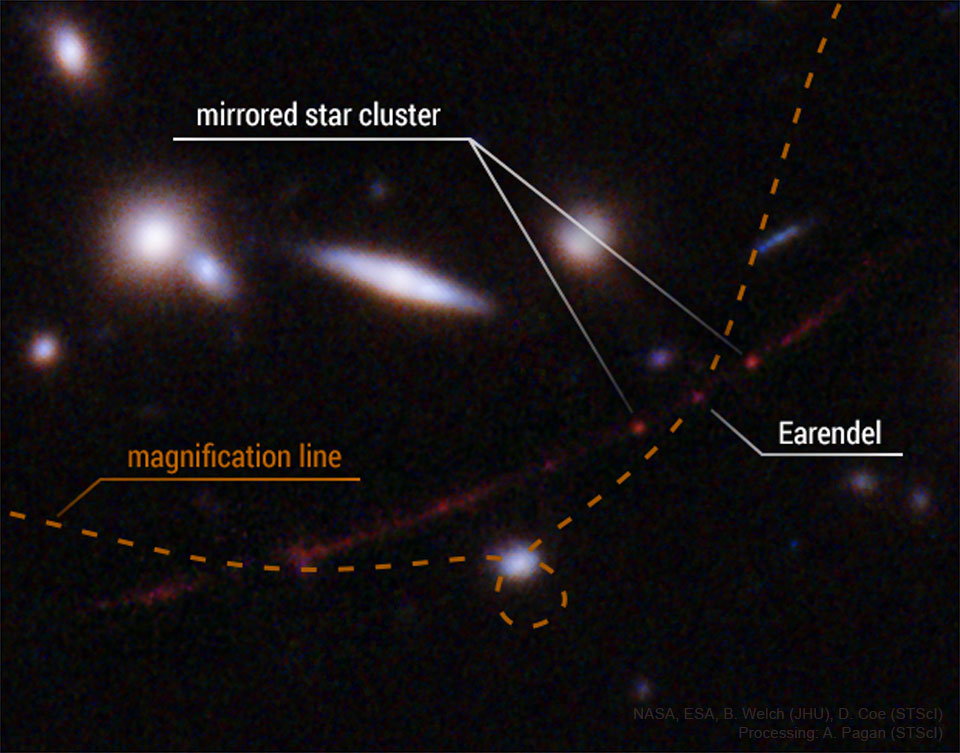06. April 2022
Earendel:早期宇宙 ê 一粒星

探索宇宙1!逐工會揀一幅無仝款 ê 影像抑是相片,𤆬你熟似咱這个迷人 ê 宇宙,閣有專業天文學者2為你3解說4。
- 原始文章:Earendel: A Star in the Early Universe
- 影像來源:NASA, ESA, B. Welch (JHU), D. Coe (STScI); 資料處理:A. Pagan (STScI)
- 台文翻譯:An-Li Tsai (NCU)
[漢羅] Earendel:早期宇宙 ê 一粒星
Earendel 敢是目前為止人類發現 ê 上遠 ê 天星? 這 tī 科學上真有可能,咱 to̍h 愛 ùi Hubble 太空望遠鏡 觀測著一个大 星系團 開始講。 咱會當 tī 遮看著星系團 ê 重力透鏡 效應 kā 遠方背景 ê 星系 放大 kah 扭曲。 這張影像 內底 ê 紅線,就是背景星系去 hŏng 扭曲 ê 形體,目前為止咱量著伊 ê 紅移 是 6.2。 紅線面頂 ê 珠珠仔,可能是一粒一粒恆星、抑是星團。 星系團透鏡 產生一條 會當放大到上大 ê 放大線,會 kā 背景疊做伙 ê 天體 放大到幾若千倍。 星系線 kah 上大放大線 ê 交叉點,有一粒珠珠仔,證明講伊是早期宇宙 ê 孤粒恆星。 這粒恆星這馬去 hŏng 號做是 Earendel。 未來 tùi Earendel 輝度 變化 ê 調查,可能會用閣較濟 ê Hubble 影像。 而且,等今年 James Webb 太空望遠鏡 開始運作了後,嘛真有可能會用伊 ê 影像。 Earendel ê 距離,比咱所知影宇宙中任何穩定 ê 恆星攏閣較遠。 毋閣這無算爆炸產生 ê GRB 090423,伊 ê 紅移 是 8.2。
[POJ] Earendel: Chá-kî ú-tiū ê chi̍t-lia̍p chhiⁿ
Earendel kám-sī bo̍k-chêng ûi-chí jîn-lūi hoat-hiān ê siōng hn̄g ê thiⁿ-chhiⁿ? Che tī kho-ha̍k siōng chin ū khó-lêng, lán to̍h ài ùi Hubble Thài-khong-bōng-oán-kiàⁿ koan-chhek tio̍h chi̍t-ê tōa seng-hē-thoân khai-sí kóng. Lán ē-tàng tī chiah khòaⁿ-tio̍h seng-hē-thoân ê tiōng-le̍k-thàu-kiàⁿ-hāu-èng kā oán-hong pōe-kéng ê seng-hē hòng-tōa kah niú-khiok. Chit-tiuⁿ iáⁿ-siōng lāi-té ê âng-sòaⁿ, tō-sī pōe-kéng seng-hē khì hŏng niú-khiok ê hêng-thé, bo̍k-chêng ûi-chí lán niû tio̍h i ê ang-î sī 6.2. Âng-sòaⁿ bīn-téng ê chu-chu-á, khó-lêng sī chi̍t-lia̍p chi̍t-lia̍p hêng-chhiⁿ, iah-sī seng-thoân. Seng-hē-thoân thàu-kiàⁿ sán-seng chi̍t-tiâu ē-tàng hòng-tōa kàu siōng tōa ê hòng-tōa-sòaⁿ, ē kā pōe-kéng tha̍h chò-hóe ê thian-thé hòng-tōa kàu kúi-ā-chheng-pōe. Seng-hē-sòaⁿ kah siōng-tōa-hòng-tōa-sòaⁿ ê kau-chhe-tiám, ū chi̍t-lia̍p chu-chu-á, chèng-bêng kóng i sī chá-kî ú-tiū ê ko͘-lia̍p hêng-chhiⁿ. Chit-lia̍p hêng-chhiⁿ chit-má khì hŏng hō chò sī Earendel. Bī-lâi tùi Earendel hui-tō͘ piàn-hòa ê tiâu-cha, khó-lêng ē iōng koh khah chōe ê Hubble iáⁿ-siōng. Jî-chhiáⁿ, tán kin-nî James Webb Thài-khong-bōng-oán-kiàⁿ khai-sí ūn-chok liáu-āu, mā chin ū khó-lêng ē iōng i ê iáⁿ-siōng. Earendel ê kū-lî, pí lán só͘ chai-iáⁿ ú-tiū tiong jīm-hô ún-tēng ê hêng-chhiⁿ lóng koh khah hn̄g. M̄-koh che bô sǹg po̍k-chà sán-seng ê GRB 090423, i ê ang-î sī 8.2.
[KIP] Earendel: Tsá-kî ú-tiū ê tsi̍t-lia̍p tshinn
Earendel kám-sī bo̍k-tsîng uî-tsí jîn-luī huat-hiān ê siōng hn̄g ê thinn-tshinn? Tse tī kho-ha̍k siōng tsin ū khó-lîng, lán to̍h ài uì Hubble Thài-khong-bōng-uán-kiànn kuan-tshik tio̍h tsi̍t-ê tuā sing-hē-thuân khai-sí kóng. Lán ē-tàng tī tsiah khuànn-tio̍h sing-hē-thuân ê tiōng-li̍k-thàu-kiànn-hāu-ìng kā uán-hong puē-kíng ê sing-hē hòng-tuā kah niú-khiok. Tsit-tiunn iánn-siōng lāi-té ê âng-suànn, tō-sī puē-kíng sing-hē khì hŏng niú-khiok ê hîng-thé, bo̍k-tsîng uî-tsí lán niû tio̍h i ê ang-î sī 6.2. Âng-suànn bīn-tíng ê tsu-tsu-á, khó-lîng sī tsi̍t-lia̍p tsi̍t-lia̍p hîng-tshinn, iah-sī sing-thuân. Sing-hē-thuân thàu-kiànn sán-sing tsi̍t-tiâu ē-tàng hòng-tuā kàu siōng tuā ê hòng-tuā-suànn, ē kā puē-kíng tha̍h tsò-hué ê thian-thé hòng-tuā kàu kuí-ā-tshing-puē. Sing-hē-suànn kah siōng-tuā-hòng-tuā-suànn ê kau-tshe-tiám, ū tsi̍t-lia̍p tsu-tsu-á, tsìng-bîng kóng i sī tsá-kî ú-tiū ê koo-lia̍p hîng-tshinn. Tsit-lia̍p hîng-tshinn tsit-má khì hŏng hō tsò sī Earendel. Bī-lâi tuì Earendel hui-tōo piàn-huà ê tiâu-tsa, khó-lîng ē iōng koh khah tsuē ê Hubble iánn-siōng. Jî-tshiánn, tán kin-nî James Webb Thài-khong-bōng-uán-kiànn khai-sí ūn-tsok liáu-āu, mā tsin ū khó-lîng ē iōng i ê iánn-siōng. Earendel ê kū-lî, pí lán sóo tsai-iánn ú-tiū tiong jīm-hô ún-tīng ê hîng-tshinn lóng koh khah hn̄g. M̄-koh tse bô sǹg po̍k-tsà sán-sing ê GRB 090423, i ê ang-î sī 8.2.
[English] Earendel: A Star in the Early Universe
Is Earendel the farthest star yet discovered? This scientific possibility started when the Hubble Space Telescope observed a huge cluster of galaxies. The gravitational lens effect of this cluster was seen to magnify and distort a galaxy far in the background. This distorted background galaxy -- so far away it has a redshift of 6.2 -- appears in the featured image as a long red string, while beads on that string are likely individual stars or star clusters. The galaxy cluster lens creates a line of maximum magnification line where superposed background objects may appear magnified many thousands of times. On the intersection between the galaxy line and the maximum magnification line is one "bead" which shows evidence of originating from a single bright star in the early universe -- now named Earendel. Future investigations may include more imaging by Hubble to see how Earendel's brightness varies, and, quite possibly, by the new James Webb Space Telescope when it becomes operational later this year. Earendel's great distance exceeds that of any known stable star -- although the star that exploded creating GRB 090423 had a redshift of 8.2.
詞彙學習
| 漢羅 | POJ | KIP | 華語 | English |
|---|---|---|---|---|
| Hubble 太空望遠鏡 | Hubble Thài-khong-bōng-oán-kiàⁿ | Hubble Thài-khong-bōng-uán-kiànn | 哈伯太空望遠鏡 | Hubble Space Telescope |
| 星系團 | seng-hē-thoân | sing-hē-thuân | 星系團 | cluster of galaxies |
| 重力透鏡效應 | tiōng-le̍k-thàu-kiàⁿ-hāu-èng | tiōng-li̍k-thàu-kiànn-hāu-ìng | 重力透鏡效應 | gravitational lens effect |
| 紅移 | ang-î | ang-î | 紅移 | redshift |
| 星系線 | seng-hē-sòaⁿ | sing-hē-suànn | 星系線 | galaxy line |
| 輝度 | hui-tō͘ | hui-tōo | 亮度 | brightness |
| 星系團透鏡 | seng-hē-thoân thàu-kiàⁿ | sing-hē-thuân thàu-kiànn | 星系團透鏡 | the galaxy cluster lens |
| James Webb 太空望遠鏡 | James Webb Thài-khong-bōng-oán-kiàⁿ | James Webb Thài-khong-bōng-uán-kiànn | 詹姆斯·韋伯太空望遠鏡 | James Webb Space Telescope |
| GRB 090423 | GRB khòng-kiú khòng-sù jī-sam | GRB khòng-kiú khòng-sù jī-sam | GRB 090423 | GRB 090423 |
| 6.2 | la̍k-tiám-jī | la̍k-tiám-jī | 6.2 | 6.2 |
| 8.2 | peh-tiám-jī | peh-tiám-jī | 8.2 | 8.2 |